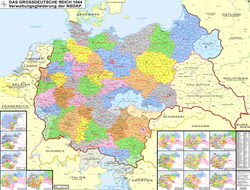Gau East Prussia
| Gau East Prussia | ||||||
| Gau of Nazi Germany | ||||||
|
||||||
|
||||||
|
Map of Nazi Germany showing its administrative subdivisions (Gaue and Reichsgaue). |
||||||
| Capital | Königsberg (now Kaliningrad) | |||||
| Gauleiter | Erich Koch | |||||
| History | ||||||
| • | Establishment | 30 January 1933 | ||||
| • | Disestablishment | 8 May 1945 | ||||
Gau East Prussia was formed in 1933 in Nazi Germany initially as a district within the Free State of Prussia. In 1935, Germany's constituent states were dissolved and the Gaus replaced the states and their responsibilities. In 1939, East Prussia expanded following the annexation of the Klaipėda Region from Lithuania and the occupation of Poland, while a sliver of territory from the gau was transferred to Reichsgau Danzig-West Prussia. After Germany's attack on the USSR, the Belarusian city of Hrodna (German: Garten) also became part of the Gau.
After the war, the territory of the former Gau became part of the RSFSR enclave of Kaliningrad in the Soviet Union, major sections were given to Poland, and the area of the Klaipėda Region was returned to the Lithuanian SSR and Hrodna - to the Belarusian SSR within the Soviet Union.
The Nazi Gau (plural Gaue) system was originally established in a party conference on 22 May 1926, in order to improve administration of the party structure. From 1933 onward, after the Nazi seizure of power, the Gaue increasingly replaced the German states as administrative subdivisions in Germany.
At the head of each Gau stood a Gauleiter, a position which became increasingly more powerful, especially after the outbreak of the Second World War, with little interference from above. Local Gauleiter often held government positions as well as party ones and were in charge of, among other things, propaganda and surveillance and, from September 1944 onward, the Volkssturm and the defense of the Gau.
...
Wikipedia



